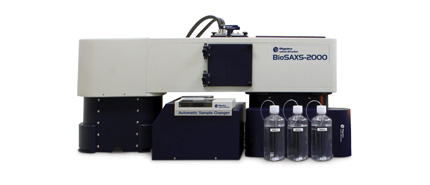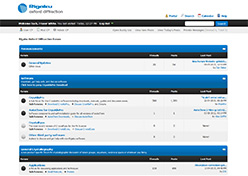|
Crystallography in the News
April 2, 2018. David Masterson recently won first place in the SSPC National Crystal Growing Competition. The Synthesis and Solid State Pharmaceutical Centre (SSPC) with iCRAG (Irish Centre for Research in Applied Geosciences), both funded by Science Foundation Ireland (SFI), announced winners of the 2017 competition at an awards ceremony last week.
April 2, 2018. Invariant natural killer T (iNKT) cells are powerful weapons our body's immune system count on to fight infection and combat diseases like cancer, multiple sclerosis, and lupus. While several chemical compounds have shown promise stimulating iNKT cells in mice, their ability to activate human iNKT cells has been limited. Now, an international team led by University of Connecticut chemistry professor Amy Howell reports the creation of a new compound that appears to have the properties researchers have been looking for.
April 2, 2018. New research has discovered water-rich material from hundreds of kilometers beneath Earth's surface, in the form of a high-pressure variety of water ice suspended within deep-mantle diamonds. Scientists found that the ice is likely a residue of a more chemically complex fluid that lives in the upper and lower layers of the mantle and influences geological processes.
April 3, 2018. Researchers from MIPT and several U.S. and Chinese universities have solved the structure of one of the most important nervous system proteins in complex with a number of drug molecules. The discovery opens up opportunities for developing new medications with regulated action and fewer side effects. The work used two chemicals to work with the 5-HT2c serotonin receptor: ergotamine and ritanserin.
April 4, 2018. Scientists in Japan, led by Dr. Yusuke Nakakuki of Kyoto University, have synthesized helical nanographene and confirmed its structure using X-ray crystallography. The researchers also found both clockwise and counter-clockwise nanographenes, which possess unique electronic structures and photoabsorption properties.
April 4, 2018. A team of researchers led by Dr. Mike Sleutel from the VIB-VUB Center for Structural Biology in collaboration with scientists from the Institute for Complex Molecular Systems of the Eindhoven University of Technology, and the CNRS in Grenoble, have for the first time uncovered the molecular details of protein crystal nucleation.
April 7, 2018. Physicists from the Russian Academy of Sciences, Crystallography & Phonetics Scientific Research Center have recently developed special nanoparticles that are able to bond into complex patterns. The process uses an ultraviolet beam to drive the particles to link up in chains.
April 9, 2018. An important complex forming the core of the cell division apparatus in stem cells has been imaged using the Macromolecular Crystallography beamlines, I04 and I04-1 at Diamond Light Source. As recently reported, the spindle orientation protein known as LGN bound to an adapter protein known as Inscuteable in a tetrameric arrangement, which drove asymmetric stem cell division.
Product Spotlight

BioSAXS-2000
Rigaku's BioSAXS-2000 SAXS camera is designed specifically to meet the needs of the structural biologist. Based on a patented two-dimensional Kratky design, the BioSAXS-2000 takes up much less space than a conventional 3-pinhole camera but offers better flux characteristics. Best of all, the BioSAXS-2000 can be mounted on the open port of a Rigaku rotating anode X-ray generator, taking full advantage of existing infrastructure, or it can be mated to a Rigaku microfocus sealed tube X-ray source. The BioSAXS AUTO configuration incorporates two time-saving features: an Automatic Sample Changer for unattended overnight operation and an Automatic Analysis Pipeline based on the world standard ATSAS package from EMBL Hamburg.
No need to wait for beamtime at a synchrotron
The BioSAXS-2000 is equipped with the new OptiSAXS optic, a doubly focusing multilayer optic whose focus is at the detector. The OptiSAXS provides better than two-fold improvement in flux compared to its predecessor resulting in higher brilliance at the sample position and data collection times in the range of minutes. Thus, the BioSAXS-2000 brings a beamline experience to home laboratory SAXS experiments.
Optional accessories
- Automatic Sample Changer (ASC) with support for up to 96 samples
- Automatic Analysis Pipeline (AAP) based on ATSAS, the world's most popular SAXS analysis software developed at EMBL Hamburg
Features
- Easily installed on the open port of an existing generator or can be installed with your choice of X-ray source: Microfocus sealed tube, MicroMax-007 HF, FR-X
- Point focusing optics eliminates smearing issues common to traditional Kratky cameras
- All system components are motorized for control from control computer
- Photodiode beamstop for intensity measurements and sample absorption correction
- Sample temperature control included with system
- 2D Kratky collimation allows one to achieve low q measurements with no realignment
- SAXSLab data collection and processing software
For more information on the BioSAXS-2000 >
Report from the BCA
This year the annual British Crystallography Association Spring meeting was held in Warwick University in the science building. As usual, Rigaku Oxford Diffraction attended and we enjoyed chatting with those of you who stopped by our booth. We were also very pleased to sponsor two poster prizes, which were won by Dr. Natalie Pridmore from the University of Bristol for her poster entitled "Spin crossover properties of iron(II) phosphine complexes" and Samar Mohapatra from the Indian Institute of Technology Madras for his poster entitled "Dissecting the role of a π-helix in thermophilic glycosyl hydrolase." Additionally, Rigaku Oxford Diffraction awarded a bursary to assist with attendance to Mr. James Bird, who is an undergraduate student from Oxford University. Congratulations to all three of you.
At the beginning of the BCA meeting, Rigaku Oxford diffraction hosted a small user meeting where Drs. Mathias Meyer, Dyanne Cruickshank and Fraser White discussed our latest products, software features and how to tackle some common data collection and processing problems. Dr. Horst Puschmann, of OlexSys, also gave a rundown of the new features in Olex2 for simplifying the handling of tricky problems like disorder.

There were many engaging discussions during the course of the meeting and we are very grateful to those who participated so actively. Thanks to all of you who attended!
Links to some of the presentations can be found below.
- Dyanne Cruickshank
XtaLAB Synergy-S: Results with the PhotonJet Ag source
- Fraser White
CrysAlisPro: Tips and tricks
- Horst Puschmann
What's new in Olex2?
Useful Links
 CrysAlisPro v39
CrysAlisPro v39
CrysAlisPro v39 has been released. Registered users can download CrysAlisPro v39 from our user forum.
Selected Recent Crystallographic Papers
Is Crystallography Useful? Editorial for Crystallography Reviews, Issue 2 of 2018. Bombicz, Petra. Crystallography Reviews. Apr2018, Vol. 24 Issue 2, p71-72. 2p. DOI: 10.1080/0889311X.2018.1412242.
Protein crystallography: methods and protocols. Gulbis, Jacqueline. Crystallography Reviews. Apr2018, Vol. 24 Issue 2, p136-143. 8p. DOI: 10.1080/0889311X.2017.1401613.
Journal of Applied Crystallography
: the first 50 years and beyond. Allen, Andrew J.; Hajdu, Janos; McIntyre, Garry J. Journal of Applied Crystallography. Apr2018, Vol. 51 Issue 2, p233-234. 1p. DOI: 10.1107/S1600576718004478.
Symmetry. Spectroscopy and crystallography: the structural nexus. Collison, David. Crystallography Reviews. Apr2018, Vol. 24 Issue 2, p144-145. 2p. DOI: 10.1080/0889311X.2017.1405947.
Solid state structural investigations of the bis(chalcone) compound with single crystal X-ray crystallography, DFT, gamma-ray spectroscopy and chemical spectroscopy methods. Yakalı, Gül; Biçer, Abdullah; Eke, Canel; Cin, Günseli Turgut. Radiation Physics & Chemistry. Apr2018, Vol. 145, p89-96. 8p. DOI: 10.1016/j.radphyschem.2017.12.002.
Synthesis, X-ray crystallography, thermogravimetric analysis and spectroscopic characterization of isostructural one-dimensional coordination polymers as sorbents for some anions. Ghanbari, Bahram; Shahhoseini, Leila; Owczarzak, Agata; Kubicki, Maciej; Kia, Reza; Raithby, Paul R. CrystEngComm. 4/7/2018, Vol. 20 Issue 13, p1783-1796. 14p. DOI: 10.1039/c7ce02017a.
Structure-guided design of potent and permeable inhibitors of MERS coronavirus 3CL protease that utilize a piperidine moiety as a novel design element. Galasiti Kankanamalage, Anushka C.; Kim, Yunjeong; Damalanka, Vishnu C.; Rathnayake, Athri D.; Fehr, Anthony R.; Mehzabeen, Nurjahan; Battaile, Kevin P.; Lovell, Scott; Lushington, Gerald H.; Perlman, Stanley; Chang, Kyeong-Ok; Groutas, William C. European Journal of Medicinal Chemistry. Apr2018, Vol. 150, p334-346. 13p. DOI: 10.1016/j.ejmech.2018.03.004.
Secondary interactions – Cement in trinuclear calcium complexes. Roşca, Sorin-Claudiu; Dorcet, Vincent; Carpentier, Jean-François; Sarazin, Yann. Inorganica Chimica Acta. Apr2018, Vol. 475, p59-64. 6p. DOI: 10.1016/j.ica.2017.08.038.
Cyclopentadienyliron boronyl carbonyls as isoelectronic analogues of cyclopentadienylmanganese carbonyls except for boronyl ligand coupling reactions. Gong, Shida; Chen, Guantao; Li, Qian-shu; Luo, Qiong; Xie, Yaoming; King, R. Bruce. Inorganica Chimica Acta. Apr2018, Vol. 475, p8-17. 10p. DOI: 10.1016/j.ica.2017.07.063.
Asymmetric ring-opening reaction of azabenzonorbornadienes with phenols promoted by palladium/(R,R)-DIOP complex. He, Zhen Xiu; Zhou, Yongyun; Han, Baiqiu; Xu, Xin; Li, Yun; Qin, Hongyu; Fan, Ruifeng; Laishram, Ronibala Devi; Fan, Baomin. Tetrahedron. Apr2018, Vol. 74 Issue 17, p2174-2181. 8p. DOI: 10.1016/j.tet.2018.03.029.
Crystallographic evolution of MAX phases in proton irradiating environments. Ward, Joseph; Middleburgh, Simon; Topping, Matthew; Garner, Alistair; Stewart, David; Barsoum, Michel W.; Preuss, Michael; Frankel, Philipp. Journal of Nuclear Materials. Apr2018, Vol. 502, p220-227. 8p. DOI: 10.1016/j.jnucmat.2018.02.008.
Molecular structure of hybrid imino-chalcone in the solid state: X-ray diffraction, spectroscopy study and third-order nonlinear optical properties. Custodio, J.M.F.; Santos, F.G.; Vaz, W.F.; Cunha, C.E.P.; Silveira, R.G.; Anjos, M.M.; Campos, C.E.M.; Oliveira, G.R.; Martins, F.T.; da Silva, C.C.; Valverde, C.; Baseia, B.; Napolitano, H.B. Journal of Molecular Structure. Apr2018, Vol. 1157, p210-221. 12p. DOI: 10.1016/j.molstruc.2017.12.023.
Analyzing shear band formation with high resolution X-ray diffraction. Pagan, Darren C.; Obstalecki, Mark; Park, Jun-Sang; Miller, Matthew P. Acta Materialia. Apr2018, Vol. 147, p133-148. 16p. DOI: 10.1016/j.actamat.2017.12.046.
The crystal structure of XdpB, the bacterial old yellow enzyme, in an FMN-free form. Zahradník, Jiří; Kolenko, Petr; Palyzová, Andrea; Černý, Jiří; Kolářová, Lucie; Kyslíková, Eva; Marešová, Helena; Grulich, Michal; Nunvar, Jaroslav; Šulc, Miroslav; Kyslík, Pavel; Schneider, Bohdan. PLoS ONE. 4/9/2018, Vol. 13 Issue 4, p1-18. 18p. DOI: 10.1371/journal.pone.0195299.
Spontaneous resolution and crystal structure of (2S)-2-(3-nitrophenyl)-3-phenyl-2,3,5,6-tetrahydro-4H-1,3-thiazin-4-one; crystal structure of rac-2-(4-nitrophenyl)-3-phenyl-2,3,5,6-tetrahydro-4H-1,3-thiazin-4-one. Yennawar, Hemant P.; Bradley, Heather G.; Perhonitch, Kristen C.; Reppert, Haley E.; Silverberg, Lee J. Acta Crystallographica: Section E. Apr2018, Vol. 74 Issue 4, p454-457. 13p. 4 Diagrams, 3 Charts. DOI: 10.1107/S2056989018003444.
Polynuclear copper(II) complexes with hexadentate Schiff base directed by the counter ion. Syntheses, crystal structures and magnetic properties. Buta, Ildiko; Cseh, Liliana; Cretu, Carmen; Aparaschivei, Diana; Maxim, Catalin; Lönnecke, Peter; Hey-Hawkins, Evamarie; Stanica, Nicolae; Ohler, Eva; Rentschler, Eva; Andruh, Marius; Costisor, Otilia. Inorganica Chimica Acta. Apr2018, Vol. 475, p133-141. 9p. DOI: 10.1016/j.ica.2017.10.024.
Synthesis, characterization, crystal structure and quantum chemical investigations of three novel coumarin-benzenesulfonohydrazide derivatives. Chethan Prathap, K.N.; Lokanath, N.K. Journal of Molecular Structure. Apr2018, Vol. 1158, p26-38. 13p. DOI: 10.1016/j.molstruc.2018.01.007.
Crystal structure and electronic properties of Sr-substituted barium disilicide Ba1-xSrxSi2 for solar cells: Computational and experimental studies. Imai, Motoharu; Kumar, Mukesh; Matsushita, Yoshitaka; Umezawa, Naoto. Acta Materialia. Apr2018, Vol. 148, p492-498. 7p. DOI: 10.1016/j.actamat.2018.02.010.
Structures and single crystal to single crystal transformations of cadmium frameworks using a flexible tripodal ligand. Zhang, Zongyao; Xu, Lijin; Cao, Rui. New Journal of Chemistry. 4/7/2018, Vol. 42 Issue 7, p5593-5601. 9p. DOI: 10.1039/c7nj05125e
Synthesis of three new thiophene condensed pyrene derivatives, crystal structure and evaluation of their photophysical properties. Moriguchi, Tetsuji; Yakeya, Daisuke; Tsuge, Akihiko; Jalli, Venkataprasad. Journal of Molecular Structure. Apr2018, Vol. 1157, p348-354. 7p. DOI: 10.1016/j.molstruc.2017.12.081.
Structural investigation of cellobiose dehydrogenase IIA: Insights from small angle scattering into intra- and intermolecular electron transfer mechanisms. Bodenheimer, Annette M.; O'Dell, William B.; Oliver, Ryan C.; Qian, Shuo; Stanley, Christopher B.; Meilleur, Flora. BBA - General Subjects. Apr2018, Vol. 1862 Issue 4, p1031-1039. 9p. DOI: 10.1016/j.bbagen.2018.01.016.
Solution scattering study of the Bacillus subtilis PgdS enzyme involved in poly-γ-glutamic acids degradation. Zeng, Jumei; Jin, Yun; Liu, Zhongchuan. PLoS ONE. 4/2/2018, Vol. 13 Issue 4, p1-13. 13p. DOI: 10.1371/journal.pone.0195355.
Effects of polysaccharide charge pattern on the microstructures of β-lactoglobulin-pectin complex coacervates, studied by SAXS and SANS. Xu, Amy Y.; Melton, Laurence D.; Ryan, Timothy M.; Mata, Jitendra P.; Rekas, Agata; Williams, Martin A.K.; McGillivray, Duncan J. Food Hydrocolloids. Apr2018, Vol. 77, p952-963. 12p. DOI: 10.1016/j.foodhyd.2017.11.045
Structural Study of the C-Terminal Domain of Nonstructural Protein 1 from Japanese Encephalitis Virus. Poonsiri, Thanalai; Wright, Gareth S. A.; Diamond, Michael S.; Turtle, Lance; Solomon, Tom; Antonyuk, Svetlana V. Journal of Virology. Apr2018, Vol. 92 Issue 7, p1-19. 19p. DOI: 10.1128/JVI.01868-17.
Structural insights into the apo-structure of Cpf1 protein from Francisella novicida. Min, Kyungjin; Yoon, Hyunjun; Jo, Inseong; Ha, Nam-Chul; Jin, Kyeong Sik; Kim, Jin-Soo; Lee, Hyung Ho. Biochemical & Biophysical Research Communications. Apr2018, Vol. 498 Issue 4, p775-781. 7p. DOI: 10.1016/j.bbrc.2018.03.057.
Book Review
 Enlightenment Now: The Case for Reason, Science, Humanism, and Progress by Steven Pinker, ISBN: 978-80525427575.
Enlightenment Now: The Case for Reason, Science, Humanism, and Progress by Steven Pinker, ISBN: 978-80525427575.
Steven Pinker's latest work, Enlightenment Now, provides an optimistic outlook on the current state of world affairs. According to Pinker, all is not doom and gloom???and he spends 453 pages explaining why. But the book isn't solely a response to the seemingly Earth-enveloping cloud of despair many Americans have felt since the 2016 election. Pinker declares in the preface: "this book is not about the forty-fifth president of the United States and his advisors. It was conceived some years before Donald Trump announced his candidacy, and I hope it will outlast his administration by many more."
Pinker appeals to Enlightenment-era philosophy???the idea that reason, science, and humanism can solve humanity's problems—as he addresses various aspects of modern society that are indeed improved, historically speaking (and don't worry, if you don't remember what the Enlightenment was—Pinker spends part one of the book, titled "Enlightenment," filling you in). Life expectancy is higher, people are healthier, generally wealth is more widespread and inequality less profound, people are generally happier—you get the idea. And you don't have to take Pinker's word for it—the book is chock-full of graphs and tables, visual representations of well-sourced data proving Pinker's points.
While certainly enlightening (pardon the pun), Pinker's book reads more like an interesting textbook than a work of popular science nonfiction. This is not a bad thing, but it definitely feels geared toward a narrow, highly educated audience: those "liberal academic elites" who were both baffled and devastated by the outcome of the 2016 election (you don't throw around words like "metastasizing," "abeyance," and "vicissitudes" if you want to reach a broad audience—even The New York Times has an 8th grade vocabulary rule). Despite Pinker's claim that the book is not a direct response to the Trump presidency, in many ways it feels like one—a reassurance that all is not lost to those for whom reason dictated that Trump could not win, and even a year and a half into his presidency, still cannot grasp how he did (Russian election meddling aside, Trump did and does still have a fair amount of supporters, unless Putin paid people individually to show up at all those rallies).
One bone to pick with Pinker: on page 252, in the chapter "Quality of Life" (which falls under Progress), he starts a paragraph with "As a feminist-era husband I can truthfully use the first-person plural in celebrating this gain"—the gain he is referring to is the invention of the washing machine, and the freedom it gave women to join the workforce and pursue other interests, aside from just hand-washing laundry day-in and day-out. Given the widespread reverberation of the #MeToo movement across dozens of industries—including academia—and the media storm that A-lister Matt Damon faced after he was questioned about Harvey Weinstein and qualified his response with one of those "as a father of four daughters"—someone should have taken this line out. It casts a somewhat unpleasant pall—certainly a highly educated academic like Pinker, who not so subtly digs at Trump throughout the book, should be clever enough not fall into such a classic pitfall. Advice for all: anytime you catch yourself, in writing or out loud, qualifying yourself "as a _____"—just don't.
Review by Jeanette S. Ferrara, MA
|









